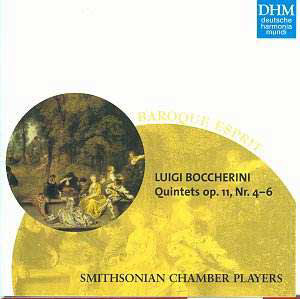Boccherini was born at Lucca (the Italian town famous for being
the home of the Puccini family) in 1843, and before he reached the age
of twenty he had become a celebrated virtuoso of the cello. His career
thereafter was truly international: in 1769 at the age of twenty-six he
moved to Madrid, where he remained for eighteen years, until he took up
the position of 'Composer of the Chamber' at the Berlin court of Friedrich
Wilhelm II of Prussia. In 1797 he returned to Spain, but without firm
patronage, and the unfortunate result was that the last years of his life
were spent in poverty.
In common with most composers of the period, he was
active in many types of music. Operas, symphonies, concertos, church
music, and most especially chamber music comprise his creative output:
he wrote well in excess of two hundred quintets for various combinations,
including nearly one hundred for string ensembles.
The Opus 11 quintets, of which three are collected
here, were composed in 1771 and published four years later. If they
are representative of Boccherini's talents, they show a composer at
the height of his powers with a ready ability to communicate. The Smithsonian
Chamber Players are distinguished musicians, and it is a particular
pleasure to encounter a booklet which details the individuals of the
ensemble and the instruments they play. In chamber music this surely
counts for something, and besides that the musicians deserve to be credited
for their considerable talents. For these are splendid performances,
at once spirited and sensitive, alert to every detail of the scores.
The performing style is authentic, and there is an
awareness of appropriate style and tempi. As a result the character
of each individual work is felt, and Boccherini easily avoids the suspicion
that a prolific composer resorts to easy formulae. Just like his contemporary
Mozart, who would also die in 1791, he finds imaginative responses to
the challenge of composing each new piece. Unlike Mozart, however, Boccherini
added a cello, not a viola, to turn quartet into quintet. He was a virtuoso
of the cello and his deep understanding of the instrument pays dividends
in the richly expressive nature of the music.
The three opening movements are particularly successful,
and set the tone for their respective works. Thus the Amoroso movement
of the A major Quintet, with its very particular title, sets a distinctive
and sensitive tone, before giving way to a more extensively developed
and lively second movement. The darker F minor Quintet opens with a
true slow movement, and again a larger and more dramatic movement follows.
In the case of the D major Quintet, the issue is more complex, since
both the first and last movements have dual characteristics, linking
faster and slower music, including in the latter case minuet with Allegro
finale.
All these features are strongly projected by the Smithsonian
musicians, who have the advantage also of a fine, clear and well balanced
recording. With interesting and informative booklet notes too, this
is a reissue which can be enthusiastically recommended, particularly
since the music is so appealing.
Terry Barfoot


